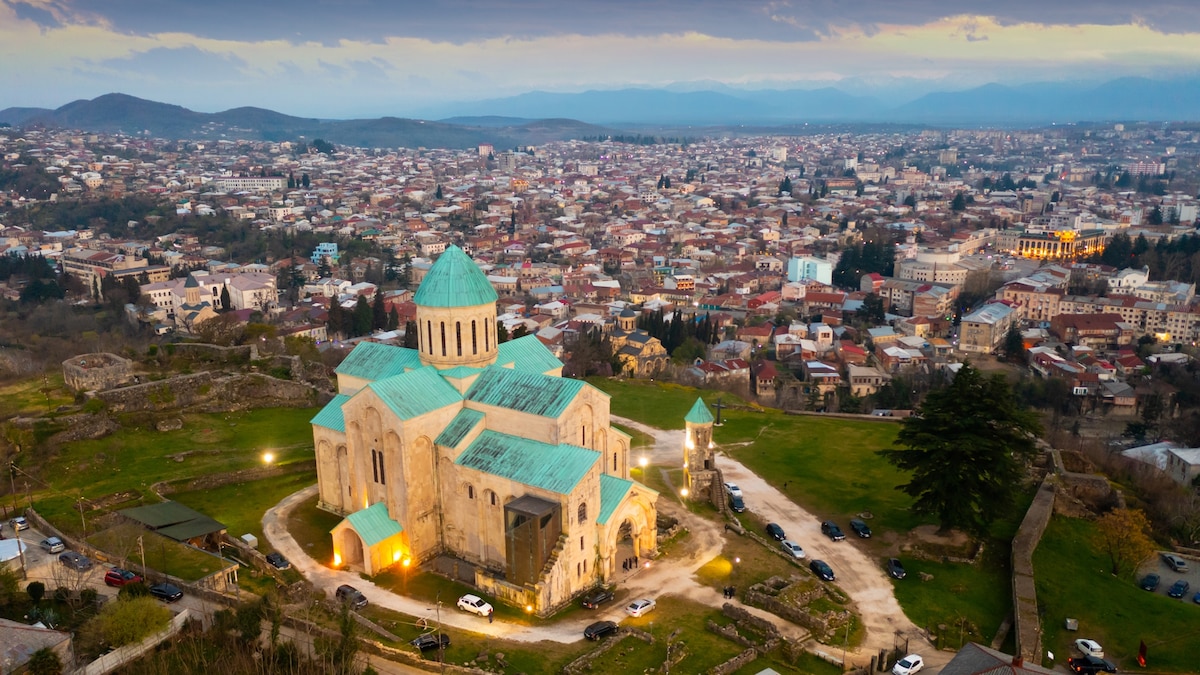Now Reading: This ancient city is a vegetarian traveler’s dream
-
01
This ancient city is a vegetarian traveler’s dream
This ancient city is a vegetarian traveler’s dream

Imereti’s capital still smells like the Silk Road; mid-Autumn air thickens with cheerful chatter and agreeable odors as locals nimbly navigate Kutaisi’s Green Bazaar. They chomp churchkhela (strings of walnuts coated in grape-juice caramel), pivot between spice stalls armed by affable matriarchs, and accept samples from spongy wheels of Imeruli cheese.
In the background, the soft soundtrack of the Rioni River interplays with the bazaar bustle. The Caucasus Mountains, Colchi plains, and Georgian highlands lie far beyond. Soon, shoppers will take their stock home and prepare a fresh daily feast to enjoy inside or on cobbled streets with cold drinks, lingering and laughing for hours. After all, a spread of Imeretian food is always shared, savored, and, as a bonus, vegetarian-friendly.

Founded in 1106, the Gelati Monastery is one of the largest medieval Orthodox monasteries.
Photograph by Dietmar Denger, laif/Redux

Monks at Gelati Monastery utilized traditional methods of winemaking, using clay vessels known as qvevris to ferment and store the wine. Above, a cross made from grape vines is displayed at the monastery.
Photograph by Oleg_0, Getty Images
How history and climate influence cuisine
Away from the trodden tourist routes of Tbilisi and Khaketi, Kutaisi (population: 180,000), was once the bureaucratic capital of Georgia, and is still considered by many to be the cultural capital. A UNESCO City of Literature, Kutaisi is fast becoming an eco-smart hub, claims the superlative of being one of the world’s oldest continuously inhabited areas, and was the site where Jason and The Argonauts had a memorable misstep searching for the Golden Fleece.
(The big trip: how to plan the ultimate Silk Road adventure through Central Asia)
Georgia is an eternal crossroads, weathering a stormy history of invasions that resulted in blends of Mediterranean, Mongol, and Persian flavors. However, land-locked Kutaisi feels authentically Georgian.
Moreover, its landlocked topography facilitates a legacy of vegetarian eating. “Imereti is an interesting region with its diverse landscape; there you can find lots of slopes, oak forests, Acacia fields, small and split cultivated lands,” says Gvantsa Abuldaze, co-owner of Baia’s Winery. “Because of less cultivated soil, people have more vegetables in their daily food than meat. It was [prevalent] for centuries and still remains.”

A mural in Kutaisi by artist Sasha Korban depicts a Georgian baker kneading dough to make khachapuri.
Photograph by Ian Fleming, Alamy Stock Photo
A communal feast
Though you’ll find no Golden Fleece in Kutaisi, you may stumble into a supra (a traditional, communal feast lasting hours and underpinned by countless toasts) and achieve shemomechama—an untranslatable word for the sensation when you are full but you continue eating anyway, as if guided by a force above you.
In post-Soviet Georgia, supra and shemomechama offer continued assurance of cultural authenticity. The terms show Georgia’s hospitality. Supra is “come hither“ incarnate, offering feast and friendliness to all at the table, family, friends, and strangers alike. As the Georgian proverb goes, “a guest is a gift from God.”
“I’m happy people are becoming more interested in Kutaisi and Imereti,” says Kristine Murusidze, lifetime Imeretian and manager of Communal Hotel Kutaisi, “there is so much heart and history here—in the food, the streets, the people.”
(Breaking bread: experiencing a supra like a true Georgian)
Try a vegan superfood
Vegetable variations appear aplenty during an Imeretian supra, but there’s one shape-shifting standout that stays consistent. Pkhali is an encompassing term for Georgian vegetable mezzes that have walnuts acting as an edible adhesive. These purple, green, and orange mounds can be spread as vegan pate, spooned, or combined with anything else on your plate to start the meal and keep your vitamins in check.
“Pkhali is very important in Imereti food,” says Murusidze. “We always start a meal with pkhali, white cheese, and made (crispy cornbread).” Though pkhali is found all over Georgia, Imeretian pkhali feels older and closer to the land.

Imeruli kachapuri is a Georgian flatbread stuffed with cheese.
Photograph by Davyd Brahin, Getty Images

Georgian vegetable mezzes (pkhali) that have walnuts acting as an edible adhesive
Photograph by Albert_Karimov, Getty Images
Murusidze corroborates this: “Many people still go to nature for wild herbs, like spinach and nettles, from early spring until late October.”
Keti Kvichidze, gastronomic advisor, echoes Murusidze, saying foraging for wild greens is more than a culinary task in this region. “It’s a cherished tradition passed down through generations,” she says. “Every spring, families venture into meadows and forests, guided by ancestral knowledge of where to find the most prized wild plants.”
Wine and flatbreads
For herb-adverse vegetarians, there are still many gastronomic delights in Kutaisi, including what could be the world’s original cheese-stuffed crust pizza. But don’t call it that. Imeruli khachapuri (a flatbread stuffed with cheese) carries a heavier nostalgic load and gastronomic dignity, than say modern-day American chain pizza stores.
(Rediscovering khachapuri, Georgia’s must-try classic)
The round, enclosed dough stuffed with Imereti cheese comes out early in the supra, like pkhali. Unlike khachapuri in other regions, the Imerulian variant features thinner dough, sharper cheese, and dough on top to ensure maximum cheese melt and pull.
“The three white grapes—Tsolikouri, Tsitska, and Krakhuna—are dominant nowadays,” says Abuldaze. “The terroir influence is easy to remark—slight acidity, white flower, and citrus aromas,” all qualities that drink fabulously with sharp Imeruli cheese.

The Kolkheti relief was created by the Georgian artist Bernard Nebieridze and is located on the side of the Green Bazaar.
Photograph by OscarEspinosa, Getty Images
Where to eat
Be sure to visit the aptly named Green Bazaar to take stock of what produce is in season. Try free samples of Laghidze Water, a natural Georgian sparkling drink invented in Kutaisi in 1887—available in pear, tarragon, quince, and other flavors.
Gala: After Kutaisi was named a UNESCO City of Literature in 2023, Gala opened the following year in honor of Galaktion Tabidze, one of Kutaisi’s most renowned poets. Poetry is at play on the plate, in the traditional clay pottery that surrounds the restaurant, and, more literally, in the book market below. There is often live music playing, as well. Try the mushroom ojakhuri eggplant with walnuts and a glass of wine.
Palaty: White wooden walls plastered with notes, gramophones, and live jazz make Palaty a sensuous spot to enjoy an extended dinner. However, if you have limited time, prioritize this spot as your dessert destination. Order pelushi: an autumnal Georgian grape juice porridge that Palaty serves up expertly; chase it with a stiff shot of chacha (best explained as Georgian grape moonshine).
Doli: Located inside the Communal Hotel, Doli serves up high-class incarnations of the classics. Firelight plays on earth-toned walls from the romantic restaurant’s ceramic fireplace while you indulge in kvari cheese dumplings (available seasonally), leek pkhali, and pomegranate seeds.
Baia’s Winery: Baia’s Winery isn’t in Kutaisi proper, but the wine tasting and Imeretian smorgasbord is worth the 40-minute drive. Owned by Abuldaze and her sister, Baia, this is an ideal place to enjoy ample pkhali, clay pot mushrooms, and conversation.
Kiki Dy is a Savannah-based writer, traveler, tea drinker, and dreamer. Her work has appeared in Savannah Magazine, Fodor’s Travel, Thrillist, EATER, The Sunday Long Read, and now National Geographic. She loves intrepid twelve-hour ferry rides to far-flung islands almost as much as the characters she collects along the way.























